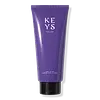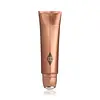What's inside
What's inside
 Key Ingredients
Key Ingredients

 Benefits
Benefits

 Concerns
Concerns

 Ingredients Side-by-side
Ingredients Side-by-side

Water
Skin ConditioningGlycerin
HumectantSilica
AbrasiveHelianthus Annuus Seed Oil
EmollientCaprylic/Capric Triglyceride
MaskingCocos Nucifera Oil
MaskingCetearyl Alcohol
EmollientCharcoal
AbrasiveGlyceryl Stearate
EmollientPEG-100 Stearate
Glycolic Acid
BufferingSodium Hydroxide
BufferingLactic Acid
BufferingTrehalose
HumectantGluconolactone
Skin ConditioningRosa Damascena Flower Water
MaskingSalvia Officinalis Oil
MaskingCarica Papaya Leaf Extract
TonicTocopherol
AntioxidantEthylhexylglycerin
Skin ConditioningButylene Glycol
HumectantCarbomer
Emulsion Stabilising1,2-Hexanediol
Skin ConditioningParfum
MaskingSodium Benzoate
MaskingPhenoxyethanol
PreservativeXanthan Gum
EmulsifyingDisodium EDTA
Water, Glycerin, Silica, Helianthus Annuus Seed Oil, Caprylic/Capric Triglyceride, Cocos Nucifera Oil, Cetearyl Alcohol, Charcoal, Glyceryl Stearate, PEG-100 Stearate, Glycolic Acid, Sodium Hydroxide, Lactic Acid, Trehalose, Gluconolactone, Rosa Damascena Flower Water, Salvia Officinalis Oil, Carica Papaya Leaf Extract, Tocopherol, Ethylhexylglycerin, Butylene Glycol, Carbomer, 1,2-Hexanediol, Parfum, Sodium Benzoate, Phenoxyethanol, Xanthan Gum, Disodium EDTA
Water
Skin ConditioningCaprylic/Capric Triglyceride
MaskingButylene Glycol
HumectantDimethicone
EmollientMica
Cosmetic ColorantGlycerin
HumectantGlyceryl Stearate
EmollientPEG-100 Stearate
Alcohol Denat.
AntimicrobialCetearyl Alcohol
EmollientCI 77891
Cosmetic ColorantMenthyl Lactate
MaskingPhenoxyethanol
PreservativeHydroxyethylcellulose
Emulsion StabilisingCaramel
Cosmetic ColorantEthylhexylglycerin
Skin ConditioningCarbomer
Emulsion StabilisingCI 77491
Cosmetic ColorantXanthan Gum
EmulsifyingSilica
AbrasiveHydrolyzed Viola Tricolor Extract
Skin ProtectingAllantoin
Skin ConditioningCaffeine
Skin ConditioningDisodium EDTA
Menthol
MaskingCamellia Oleifera Seed Oil
Skin ConditioningRosa Canina Fruit Oil
EmollientCI 77492
Cosmetic ColorantSodium Hydroxide
BufferingCI 77499
Cosmetic ColorantRosa Damascena Extract
MaskingPEG-8
HumectantAloe Barbadensis Leaf Juice Powder
Skin ConditioningMichelia Alba Leaf Oil
MaskingSodium Hyaluronate
HumectantTocopherol
AntioxidantPentylene Glycol
Skin ConditioningLentinus Edodes Extract
Skin ConditioningTin Oxide
AbrasiveAscorbyl Palmitate
AntioxidantAscorbic Acid
AntioxidantCitric Acid
BufferingLinalool
PerfumingCitronellol
PerfumingGeraniol
PerfumingWater, Caprylic/Capric Triglyceride, Butylene Glycol, Dimethicone, Mica, Glycerin, Glyceryl Stearate, PEG-100 Stearate, Alcohol Denat., Cetearyl Alcohol, CI 77891, Menthyl Lactate, Phenoxyethanol, Hydroxyethylcellulose, Caramel, Ethylhexylglycerin, Carbomer, CI 77491, Xanthan Gum, Silica, Hydrolyzed Viola Tricolor Extract, Allantoin, Caffeine, Disodium EDTA, Menthol, Camellia Oleifera Seed Oil, Rosa Canina Fruit Oil, CI 77492, Sodium Hydroxide, CI 77499, Rosa Damascena Extract, PEG-8, Aloe Barbadensis Leaf Juice Powder, Michelia Alba Leaf Oil, Sodium Hyaluronate, Tocopherol, Pentylene Glycol, Lentinus Edodes Extract, Tin Oxide, Ascorbyl Palmitate, Ascorbic Acid, Citric Acid, Linalool, Citronellol, Geraniol
Ingredients Explained
These ingredients are found in both products.
Ingredients higher up in an ingredient list are typically present in a larger amount.
Butylene Glycol (or BG) is used within cosmetic products for a few different reasons:
Overall, Butylene Glycol is a safe and well-rounded ingredient that works well with other ingredients.
Though this ingredient works well with most skin types, some people with sensitive skin may experience a reaction such as allergic rashes, closed comedones, or itchiness.
Learn more about Butylene GlycolThis ingredient is an emollient, solvent, and texture enhancer. It is considered a skin-softener by helping the skin prevent moisture loss.
It helps thicken a product's formula and makes it easier to spread by dissolving clumping compounds.
Caprylic Triglyceride is made by combining glycerin with coconut oil, forming a clear liquid.
While there is an assumption Caprylic Triglyceride can clog pores due to it being derived from coconut oil, there is no research supporting this.
Learn more about Caprylic/Capric TriglycerideCarbomer is a polymer of acrylic acid. Its main role is to create a gel consistency.
A high amount of carbomer can cause pilling or balling up of products. Don't worry, most products contain 1% or less of carbomer.
Cetearyl alcohol is a mixture of two fatty alcohols: cetyl alcohol and stearyl alcohol. It is mainly used as an emulsifier. Emulsifiers help prevent the separation of oils and products. Due to its composition, it can also be used to thicken a product or help create foam.
Cetearyl alcohol is an emollient. Emollients help soothe and hydrate the skin by trapping moisture.
Studies show Cetearyl alcohol is non-toxic and non-irritating. The FDA allows products labeled "alcohol-free" to have fatty alcohols.
This ingredient is usually derived from plant oils such as palm, vegetable, or coconut oils. There is debate on whether this ingredient will cause acne.
Due to the fatty acid base, this ingredient may not be Malassezia folliculitis safe.
Learn more about Cetearyl AlcoholDisodium EDTA plays a role in making products more stable by aiding other preservatives.
It is a chelating agent, meaning it neutralizes metal ions that may be found in a product.
Disodium EDTA is a salt of edetic acid and is found to be safe in cosmetic ingredients.
Learn more about Disodium EDTAEthylhexylglycerin (we can't pronounce this either) is commonly used as a preservative and skin softener. It is derived from glyceryl.
You might see Ethylhexylglycerin often paired with other preservatives such as phenoxyethanol. Ethylhexylglycerin has been found to increase the effectiveness of these other preservatives.
Glycerin is already naturally found in your skin. It helps moisturize and protect your skin.
A study from 2016 found glycerin to be more effective as a humectant than AHAs and hyaluronic acid.
As a humectant, it helps the skin stay hydrated by pulling moisture to your skin. The low molecular weight of glycerin allows it to pull moisture into the deeper layers of your skin.
Hydrated skin improves your skin barrier; Your skin barrier helps protect against irritants and bacteria.
Glycerin has also been found to have antimicrobial and antiviral properties. Due to these properties, glycerin is often used in wound and burn treatments.
In cosmetics, glycerin is usually derived from plants such as soybean or palm. However, it can also be sourced from animals, such as tallow or animal fat.
This ingredient is organic, colorless, odorless, and non-toxic.
Glycerin is the name for this ingredient in American English. British English uses Glycerol/Glycerine.
Learn more about GlycerinGlyceryl Stearate is a mix of glycerin and stearic acid.
It is used to stabilize the mixing of water and oil ingredients. By preventing these ingredients from separating, it can help elongate shelf life. It can also help thicken the product's texture.
As an emollient, it helps soften skin and supports barrier-replenishing ingredients.
In cosmetics, Glyceryl Stearate is often made from vegetable oils or synthetically produced.
This ingredient may not be fungal-acne safe
Fun fact: The human body also creates Glyceryl Stearate naturally.
Learn more about Glyceryl StearatePeg-100 Stearate is an emollient and emulsifier. As an emollient, it helps keep skin soft by trapping moisture in. On the other hand, emulsifiers help prevent oil and water from separating in a product.
PEGS are a hydrophilic polyether compound . There are 100 ethylene oxide monomers in Peg-100 Stearate. Peg-100 Stearate is polyethylene glycol ester of stearic acid.
Phenoxyethanol is a preservative that has germicide, antimicrobial, and aromatic properties. Studies show that phenoxyethanol can prevent microbial growth. By itself, it has a scent that is similar to that of a rose.
It's often used in formulations along with Caprylyl Glycol to preserve the shelf life of products.
Silica, also known as silicon dioxide, is a naturally occurring mineral. It is used as a fine, spherical, and porous powder in cosmetics.
Though it has exfoliant properties, the function of silica varies depending on the product.
The unique structure of silica enhances the spreadability and adds smoothness, making it a great texture enhancer.
It is also used as an active carrier, emulsifier, and mattifier due to its ability to absorb excess oil.
In some products, tiny microneedles called spicules are made from silica or hydrolyzed sponge. When you rub them in, they lightly polish away dead skin layers and enhance the penetration of active ingredients.
Learn more about SilicaSodium Hydroxide is also known as lye or caustic soda. It is used to adjust the pH of products; many ingredients require a specific pH to be effective.
In small amounts, sodium hydroxide is considered safe to use. However, large amounts may cause chemical burns due to its high alkaline.
Your skin has a natural pH and acid mantle. This acid mantle helps prevent harmful bacteria from breaking through. The acid mantle also helps keep your skin hydrated.
"Alkaline" refers to a high pH level. A low pH level would be considered acidic.
Learn more about Sodium HydroxideTocopherol (also known as Vitamin E) is a common antioxidant used to help protect the skin from free-radicals and strengthen the skin barrier. It's also fat soluble - this means our skin is great at absorbing it.
Vitamin E also helps keep your natural skin lipids healthy. Your lipid skin barrier naturally consists of lipids, ceramides, and fatty acids. Vitamin E offers extra protection for your skin’s lipid barrier, keeping your skin healthy and nourished.
Another benefit is a bit of UV protection. Vitamin E helps reduce the damage caused by UVB rays. (It should not replace your sunscreen). Combining it with Vitamin C can decrease sunburned cells and hyperpigmentation after UV exposure.
You might have noticed Vitamin E + C often paired together. This is because it is great at stabilizing Vitamin C. Using the two together helps increase the effectiveness of both ingredients.
There are often claims that Vitamin E can reduce/prevent scarring, but these claims haven't been confirmed by scientific research.
Learn more about TocopherolWater. It's the most common cosmetic ingredient of all. You'll usually see it at the top of ingredient lists, meaning that it makes up the largest part of the product.
So why is it so popular? Water most often acts as a solvent - this means that it helps dissolve other ingredients into the formulation.
You'll also recognize water as that liquid we all need to stay alive. If you see this, drink a glass of water. Stay hydrated!
Learn more about WaterXanthan gum is used as a stabilizer and thickener within cosmetic products. It helps give products a sticky, thick feeling - preventing them from being too runny.
On the technical side of things, xanthan gum is a polysaccharide - a combination consisting of multiple sugar molecules bonded together.
Xanthan gum is a pretty common and great ingredient. It is a natural, non-toxic, non-irritating ingredient that is also commonly used in food products.
Learn more about Xanthan Gum